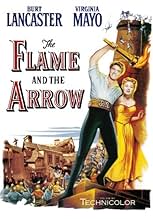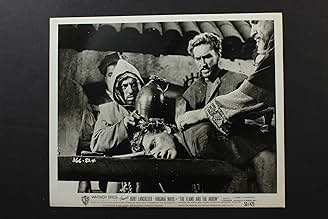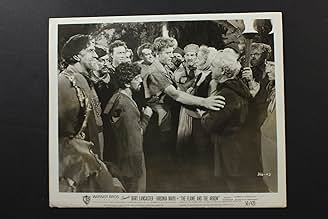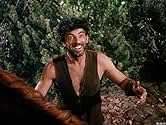VALUTAZIONE IMDb
6,8/10
4490
LA TUA VALUTAZIONE
Aggiungi una trama nella tua linguaDardo, a Robin Hood-like figure, and his loyal followers use a Roman ruin in Medieval Lombardy as their headquarters as they conduct an insurgency against their Hessian conquerors.Dardo, a Robin Hood-like figure, and his loyal followers use a Roman ruin in Medieval Lombardy as their headquarters as they conduct an insurgency against their Hessian conquerors.Dardo, a Robin Hood-like figure, and his loyal followers use a Roman ruin in Medieval Lombardy as their headquarters as they conduct an insurgency against their Hessian conquerors.
- Regia
- Sceneggiatura
- Star
- Candidato a 2 Oscar
- 2 vittorie e 2 candidature totali
Lynn Baggett
- Francesca
- (as Lynne Baggett)
Paul Baxley
- Guard
- (non citato nei titoli originali)
Leon Belasco
- Arturo of Milan
- (non citato nei titoli originali)
- …
Ray Beltram
- Townsman
- (non citato nei titoli originali)
Richard Brehm
- Outlaw
- (non citato nei titoli originali)
George Bruggeman
- Guard
- (non citato nei titoli originali)
Recensioni in evidenza
Dardo (Burt Lancaster) The Arrow , a Robin Hood-like outlaw in Medieval Italy under power of Federico I Redbeard leads his gang of mountain freedom fighters versus a mercenary warlord , Count 'The Hawk' Ulrich (Frank Allenby who provides personable villainy) who has seduced his spouse Francesca (as Lynne Baggett) and abducted his child . Dardo , his pal Piccolo (Nick Cravat) and his loyal followers and local rebels use a Roman ruin as their headquarter , and all of them fight against their tyrannical overlord carrying out an astute insurgency . Later on , Dardo kidnaps Hawk's niece and then it happens the usual romantic interludes with lovely hostage Anne (Viginia Mayo) and subsequently to battle the Hessian conquerors .
This is a joyous adventure movie with spectacular acrobatics , action-filled , including thrills , fights , duels , marvelous outdoors , a cast of thousands as well as Lancaster and Cravat performing their own stunts adding interest to the ordinary swashbuckling . Deemed by many to be one of the best adventure movie laced with comedy and enthusiastically paced . Burt Lancaster was a great actor as well as big on athletic prowess and highly enjoyable to watch on-screen . Here Burt spectacularly runs , rides , shoots arrows , bounds and leaps . This top-notch adventure established the handsome Burt as the natural successor to Douglas Fraibanks Sr , Douglas Fairbanks Jr and Errol Flynn in Warner Brothers' swashbucklers . It also strengthened his credentials as a leading man and not just another swashbuckling hero , from then on he started to get much wider range of characters . Lancaster teamed with his ex-circus colleague Nick Cravat , long-time acrobatic partner appeared with Burt in nine films . Cravat according to reports was as strong as a bull , he may have been short on stature but he was a real acrobat . In this film and The Crimson pirate (1952), Nick played characters that were mute and this was because he spoke with a very thick Brooklyn accent that he could not shake , and it would have been wildly out of place in such period costume dramas . Before his Hollywood acting carrier Nick Cravat also worked in the circus with Burt in a Rolla-Bolla duo act known as the Saxons . He partnered with Lancaster in a perch-pole balancing act where Nick , as bottom man , balanced Burt forehead atop a ten foot perch-pole . Support cast is pretty good , such as : Frank Allenby , Aline MacMahon , Lynn Baggett , Norman Lloyd as Apollo The Troubador , Victor Kilian as Apothecary and the British Robert Douglas , once a national fencing champion . And uncredited Richard Farnsworth as an outlaw . ¨The flame and the arrow¨ (1950) was 11th biggest grossing movie in the world for the year , recouping several times its original cost to the surprise of the studio . It displays a colorful cinematography in Technicolor by Ernest Haller . And a thrilling and evocative musical score by the classic composer Max Steiner .
This derring-do film was professionally directed by the underrated filmmaker Jacques Tourneur , though the present-day he is better considered . Jacques directed all kinds of genres , such as : Western : ¨Great day in the morning¨, ¨Stranger on horseback¨, ¨Canyon passage¨, ¨Wichita¨ ; Terror : ¨Curse of demon¨, ¨I Walked with a Zombie¨, ¨Leopard man¨ , ¨Cat people¨, ¨Comedy of terrors¨ ; Film Noir :¨Out the past¨, ¨Berlin express¨, ¨Experiment perilous¨ , ¨Nightfall¨ and Adventure : ¨The giant of Marathon¨ , ¨Tombuctú¨, ¨Martin the gaucho¨ , ¨Anne of the Indians¨ and ¨The flame and the arrow¨.
This is a joyous adventure movie with spectacular acrobatics , action-filled , including thrills , fights , duels , marvelous outdoors , a cast of thousands as well as Lancaster and Cravat performing their own stunts adding interest to the ordinary swashbuckling . Deemed by many to be one of the best adventure movie laced with comedy and enthusiastically paced . Burt Lancaster was a great actor as well as big on athletic prowess and highly enjoyable to watch on-screen . Here Burt spectacularly runs , rides , shoots arrows , bounds and leaps . This top-notch adventure established the handsome Burt as the natural successor to Douglas Fraibanks Sr , Douglas Fairbanks Jr and Errol Flynn in Warner Brothers' swashbucklers . It also strengthened his credentials as a leading man and not just another swashbuckling hero , from then on he started to get much wider range of characters . Lancaster teamed with his ex-circus colleague Nick Cravat , long-time acrobatic partner appeared with Burt in nine films . Cravat according to reports was as strong as a bull , he may have been short on stature but he was a real acrobat . In this film and The Crimson pirate (1952), Nick played characters that were mute and this was because he spoke with a very thick Brooklyn accent that he could not shake , and it would have been wildly out of place in such period costume dramas . Before his Hollywood acting carrier Nick Cravat also worked in the circus with Burt in a Rolla-Bolla duo act known as the Saxons . He partnered with Lancaster in a perch-pole balancing act where Nick , as bottom man , balanced Burt forehead atop a ten foot perch-pole . Support cast is pretty good , such as : Frank Allenby , Aline MacMahon , Lynn Baggett , Norman Lloyd as Apollo The Troubador , Victor Kilian as Apothecary and the British Robert Douglas , once a national fencing champion . And uncredited Richard Farnsworth as an outlaw . ¨The flame and the arrow¨ (1950) was 11th biggest grossing movie in the world for the year , recouping several times its original cost to the surprise of the studio . It displays a colorful cinematography in Technicolor by Ernest Haller . And a thrilling and evocative musical score by the classic composer Max Steiner .
This derring-do film was professionally directed by the underrated filmmaker Jacques Tourneur , though the present-day he is better considered . Jacques directed all kinds of genres , such as : Western : ¨Great day in the morning¨, ¨Stranger on horseback¨, ¨Canyon passage¨, ¨Wichita¨ ; Terror : ¨Curse of demon¨, ¨I Walked with a Zombie¨, ¨Leopard man¨ , ¨Cat people¨, ¨Comedy of terrors¨ ; Film Noir :¨Out the past¨, ¨Berlin express¨, ¨Experiment perilous¨ , ¨Nightfall¨ and Adventure : ¨The giant of Marathon¨ , ¨Tombuctú¨, ¨Martin the gaucho¨ , ¨Anne of the Indians¨ and ¨The flame and the arrow¨.
Lively, colorful period romp in the Warners’ style made in the wake of ADVENTURES OF DON JUAN (1948) – featuring the same villain, Robert Douglas, no less – but actually fashioned after their most successful swashbuckler, THE ADVENTURES OF ROBIN HOOD (1938).
Burt Lancaster – with his acrobatic training and cheerful countenance in full bloom – is perfect casting for the heroic role of Dardo, a kind of Italian Robin Hood (even down to displaying similar prowess as an archer); Virginia Mayo, then, makes for an ideal heroine – like Olivia De Havilland’s Maid Marian, playing a noble woman who’s gradually drawn to the outlaw’s cause. Again, like the 1938 Robin Hood film, we have two villains: Frank Allenby as a tyrant known as “The Hawk” and the afore-mentioned Douglas as a Marquis; the latter’s role is interesting in that, banished by the former for tax evasion, he manages to infiltrate Lancaster’s band (along with his smart companion, a troubadour played by Norman Lloyd) and outwardly reform – but, when the opportunity arises, proceeds to reveal their plan of attack to Allenby!
Other twists and quirks to the Robin Hood formula (the sharp script was written by Waldo Salt, later an Oscar winner for MIDNIGHT COWBOY [1969]!) are the fact that Lancaster’s wife has left him for Allenby - their spirited son has remained with Lancaster, whom he idolizes, but is eventually captured and thought good manners against his will; when Lancaster imprisons Mayo in exchange for his son’s freedom, he keeps her chained by the neck to a tree!; for no apparent reason other than that he's able to, one of Lancaster’s men uses his feet to write ransom notes, etc.; Lancaster is sent to the gallows but, here, he gives himself up rather than being captured and actually fakes his own death!; and the climactic struggle inside the castle, which the gang penetrate incognito (this time dressed-up as a band of strolling players). The obligatory swordfight between Lancaster and Douglas, then, is given a novel touch by being partly set in the dark – the only evident nod to the noir style director Tourneur is best-known for!
The film itself received a couple of Oscar nominations for Ernest Haller’s gorgeous cinematography and Max Steiner’s marvelous score (it too bears a striking resemblance to Erich Wolfgang Korngold’s unforgettable work on THE ADVENTURES OF ROBIN HOOD – as do the castle interiors – but this takes nothing away from the quality of THE FLAME AND THE ARROW itself!). Also worth noting in the cast is Nick Cravat as Lancaster’s mute sidekick: in the star’s days as an acrobat, he had been his partner and would often work with him in films – basically reprising his role here in Lancaster’s next swashbuckler, the seafaring THE CRIMSON PIRATE (1952; incidentally, also surprisingly but vigorously helmed by an expert in film noir, Robert Siodmak). Speaking of the latter, a couple of years back I re-acquainted myself with it via a rental of Warner’s bare-bones DVD edition – but its predecessor/companion piece is, mysteriously, still M.I.A. on disc...
Burt Lancaster – with his acrobatic training and cheerful countenance in full bloom – is perfect casting for the heroic role of Dardo, a kind of Italian Robin Hood (even down to displaying similar prowess as an archer); Virginia Mayo, then, makes for an ideal heroine – like Olivia De Havilland’s Maid Marian, playing a noble woman who’s gradually drawn to the outlaw’s cause. Again, like the 1938 Robin Hood film, we have two villains: Frank Allenby as a tyrant known as “The Hawk” and the afore-mentioned Douglas as a Marquis; the latter’s role is interesting in that, banished by the former for tax evasion, he manages to infiltrate Lancaster’s band (along with his smart companion, a troubadour played by Norman Lloyd) and outwardly reform – but, when the opportunity arises, proceeds to reveal their plan of attack to Allenby!
Other twists and quirks to the Robin Hood formula (the sharp script was written by Waldo Salt, later an Oscar winner for MIDNIGHT COWBOY [1969]!) are the fact that Lancaster’s wife has left him for Allenby - their spirited son has remained with Lancaster, whom he idolizes, but is eventually captured and thought good manners against his will; when Lancaster imprisons Mayo in exchange for his son’s freedom, he keeps her chained by the neck to a tree!; for no apparent reason other than that he's able to, one of Lancaster’s men uses his feet to write ransom notes, etc.; Lancaster is sent to the gallows but, here, he gives himself up rather than being captured and actually fakes his own death!; and the climactic struggle inside the castle, which the gang penetrate incognito (this time dressed-up as a band of strolling players). The obligatory swordfight between Lancaster and Douglas, then, is given a novel touch by being partly set in the dark – the only evident nod to the noir style director Tourneur is best-known for!
The film itself received a couple of Oscar nominations for Ernest Haller’s gorgeous cinematography and Max Steiner’s marvelous score (it too bears a striking resemblance to Erich Wolfgang Korngold’s unforgettable work on THE ADVENTURES OF ROBIN HOOD – as do the castle interiors – but this takes nothing away from the quality of THE FLAME AND THE ARROW itself!). Also worth noting in the cast is Nick Cravat as Lancaster’s mute sidekick: in the star’s days as an acrobat, he had been his partner and would often work with him in films – basically reprising his role here in Lancaster’s next swashbuckler, the seafaring THE CRIMSON PIRATE (1952; incidentally, also surprisingly but vigorously helmed by an expert in film noir, Robert Siodmak). Speaking of the latter, a couple of years back I re-acquainted myself with it via a rental of Warner’s bare-bones DVD edition – but its predecessor/companion piece is, mysteriously, still M.I.A. on disc...
One of the more enjoyable swinging-from-the-chandelier-with-a- -sword adventures made a la Erroll Flynn. A lively pace, loads of action, a witty-if-fluffy script, an enchanting score, good performances, and above all an incredible number of acrobatic stunts make this utterly enjoyable. Lancaster had been a circus acrobat before he got into films, and managed to work every stunt he could do into the script. He even balances and poses on the top of a 20-foot pole, for real. I'm still amazed that a guy that big could be so good.
(This film also had an ongoing effect on Hollywood: At the time Lancaster's career was fading, he was typecast as a big dumb lug in the kind of Film Noir that was rapidly going out of fashion. He realized that he had to do something, and rather than rely on the studios he bought this script and produced it himself. And gave himself a whole new career, an example not lost on other actors. This was one of the films that marked the beginning of the end of the paternalistic studio system, one that showed actors that they could control their own careers. For good or ill.)
(This film also had an ongoing effect on Hollywood: At the time Lancaster's career was fading, he was typecast as a big dumb lug in the kind of Film Noir that was rapidly going out of fashion. He realized that he had to do something, and rather than rely on the studios he bought this script and produced it himself. And gave himself a whole new career, an example not lost on other actors. This was one of the films that marked the beginning of the end of the paternalistic studio system, one that showed actors that they could control their own careers. For good or ill.)
I honestly feel if anyone is does this film down for it's jovial nature then they surely are missing the point. I wasn't around at the time of its release, but I would have been surprised if the makers had marketed it as a searing swashbuckler for the ages. The film is fun, it tells a fun tale, and yes it's in the Robin Hood arc of plot structure, but ultimately it's a tale well worth watching due to the extended dexterity of its stars.
I would think that tagging this film "The Acrobatic Peasant Vs The Horrible Hessian Lord" would serve it about right, the cast are having fun and really the viewer should be in on the joviality unfolding as well. Burt Lancaster and his old circus performing pal Nick Cravat dazzle with flings and flops, arrows and lances, and it all works for what I term perfect Sunday afternoon entertainment.
All that and Viginia Mayo has a smile that could stop an army in its tracks, what more do you want ?, hooray ! 7/10
I would think that tagging this film "The Acrobatic Peasant Vs The Horrible Hessian Lord" would serve it about right, the cast are having fun and really the viewer should be in on the joviality unfolding as well. Burt Lancaster and his old circus performing pal Nick Cravat dazzle with flings and flops, arrows and lances, and it all works for what I term perfect Sunday afternoon entertainment.
All that and Viginia Mayo has a smile that could stop an army in its tracks, what more do you want ?, hooray ! 7/10
"The Flame & The Arrow" (1950)was one of the last of the great Warner Bros. swashbucklers. From a screenplay by Waldo Salt this hugely enjoyable romp was directed with great flair by Jacques Tourneur. It was originally planned as a vehicle for Errol Flynn but by the time the picture went into production the erstwhile heroic Flynn was past his sell-by date and would be unable for the knockabout antics the part demanded (he had barely got through "The Adventures Of Don Juan" two years previously thanks to many short takes and having doubles perform a lot of his action scenes). Instead, a young and stunningly acrobatic Burt Lancaster was cast as Dardo, a sort of Robin Hood in medieval Italy fighting the oppression of the occupying Hessions.
Produced by Lancaster's Norma Productions (named after his wife) it was fully fleshed out with a splendid cast. Playing Dardo's mute friend Piccolo was Nick Cravat - Lancaster's friend and fellow performer from their circus days.The lovely Virginia Mayo played the love interest Anne of Hess. Robert Douglas is a likable rogue through most of the picture until he gets a taste of power and turns bad and Frank Allenby, looking remarkably like the Great Profile John Barrymore, played the villainous Hawk (the original title of the movie was "The Hawk & The Arrow").
Lancaster is marvellous to watch! Performing all his own stunts his high flying antics are a joy to behold. No other actor, before or since, would prove to be so agile and provide such a spirited performance! His athletic prowess is outstanding and little wonder he was Warner's first choice to play the great native American athlete Jim Thorpe in their biographical "Jim Thorpe-All American" (aka "Man Of Bronz") in 1952. Although he did a kind of follow-up to "The Flame & The Arrow" two years later with the more comical "The Crimson Pirate" it is a shame he then ceased doing this type of movie as we could have tolerated him in quite a few more of them.
Beautifully photographed in colour by the great Ernest Haller the movie has all the hallmarks of Warner's high production values. Adding greatly to the picture's proceedings is the wonderful Italianate score by Max Steiner! His ebullient music, like the picture, is a total delight especially his infectious and hum inducing main theme for Dardo scored for mandolins and orchestra and the gorgeous love theme for the scenes with Dardo & the lady Anne. There's a splendid driving battle theme too! Steiner's music was nominated for an Acadamy Award but lost out to Franz Waxman's darker "Sunset Boulevard".
The picture has transferred extremely well to disc with sharp images and fine colour resolution but quite dispensable are a Merrie Melodies cartoon and a tired Joe McDoakes short. It is also a pity that a documentary of Lancaster was not included.
Produced by Lancaster's Norma Productions (named after his wife) it was fully fleshed out with a splendid cast. Playing Dardo's mute friend Piccolo was Nick Cravat - Lancaster's friend and fellow performer from their circus days.The lovely Virginia Mayo played the love interest Anne of Hess. Robert Douglas is a likable rogue through most of the picture until he gets a taste of power and turns bad and Frank Allenby, looking remarkably like the Great Profile John Barrymore, played the villainous Hawk (the original title of the movie was "The Hawk & The Arrow").
Lancaster is marvellous to watch! Performing all his own stunts his high flying antics are a joy to behold. No other actor, before or since, would prove to be so agile and provide such a spirited performance! His athletic prowess is outstanding and little wonder he was Warner's first choice to play the great native American athlete Jim Thorpe in their biographical "Jim Thorpe-All American" (aka "Man Of Bronz") in 1952. Although he did a kind of follow-up to "The Flame & The Arrow" two years later with the more comical "The Crimson Pirate" it is a shame he then ceased doing this type of movie as we could have tolerated him in quite a few more of them.
Beautifully photographed in colour by the great Ernest Haller the movie has all the hallmarks of Warner's high production values. Adding greatly to the picture's proceedings is the wonderful Italianate score by Max Steiner! His ebullient music, like the picture, is a total delight especially his infectious and hum inducing main theme for Dardo scored for mandolins and orchestra and the gorgeous love theme for the scenes with Dardo & the lady Anne. There's a splendid driving battle theme too! Steiner's music was nominated for an Acadamy Award but lost out to Franz Waxman's darker "Sunset Boulevard".
The picture has transferred extremely well to disc with sharp images and fine colour resolution but quite dispensable are a Merrie Melodies cartoon and a tired Joe McDoakes short. It is also a pity that a documentary of Lancaster was not included.
Lo sapevi?
- QuizNick Cravat, who plays Piccolo, was an acrobat who was teamed with Burt Lancaster before Lancaster became a star. He appears in many of Lancaster's movies. In this one, and in Il corsaro dell'isola verde (1952), he plays a mute. The reason was that his thick Brooklyn accent, which he could not lose, would have been wildly out of place in such period pieces.
- BlooperWhen Piccolo is fighting the guardsman in the balcony he flips his sword around and holds the blade with his hand (showing it cannot be sharp) and then whacks the guardsman with the broad side of the blade near the hilt, bending it at least 20-25 degrees.
- ConnessioniReferenced in The John Player Lecture with Burt Lancaster (1972)
I più visti
Accedi per valutare e creare un elenco di titoli salvati per ottenere consigli personalizzati
- How long is The Flame and the Arrow?Powered by Alexa
Dettagli
- Data di uscita
- Paese di origine
- Lingua
- Celebre anche come
- El halcón y la flecha
- Luoghi delle riprese
- Aziende produttrici
- Vedi altri crediti dell’azienda su IMDbPro
Botteghino
- Budget
- 1.600.000 USD (previsto)
- Lordo in tutto il mondo
- 6713 USD
- Tempo di esecuzione
- 1h 28min(88 min)
- Proporzioni
- 1.37 : 1
Contribuisci a questa pagina
Suggerisci una modifica o aggiungi i contenuti mancanti






































